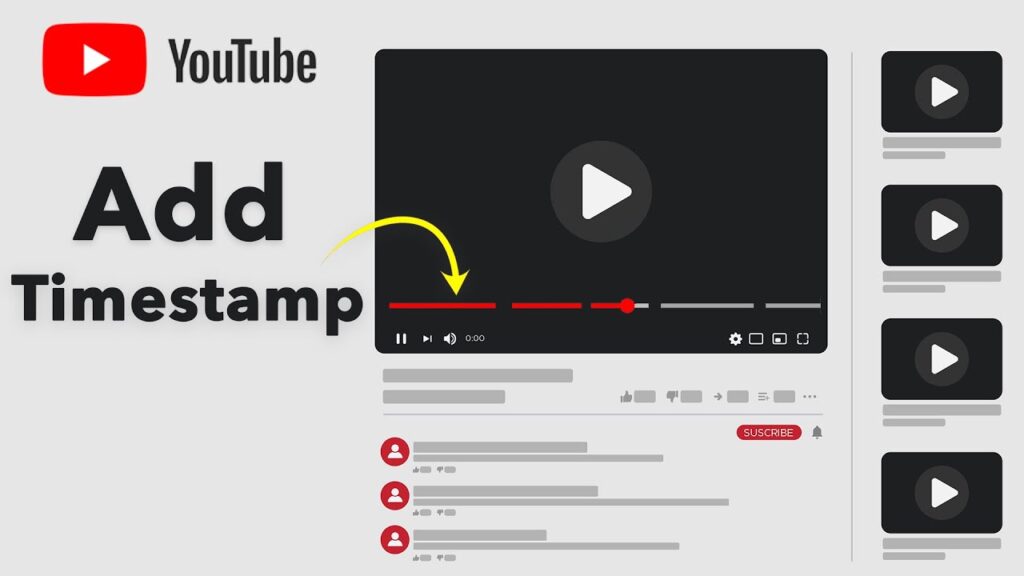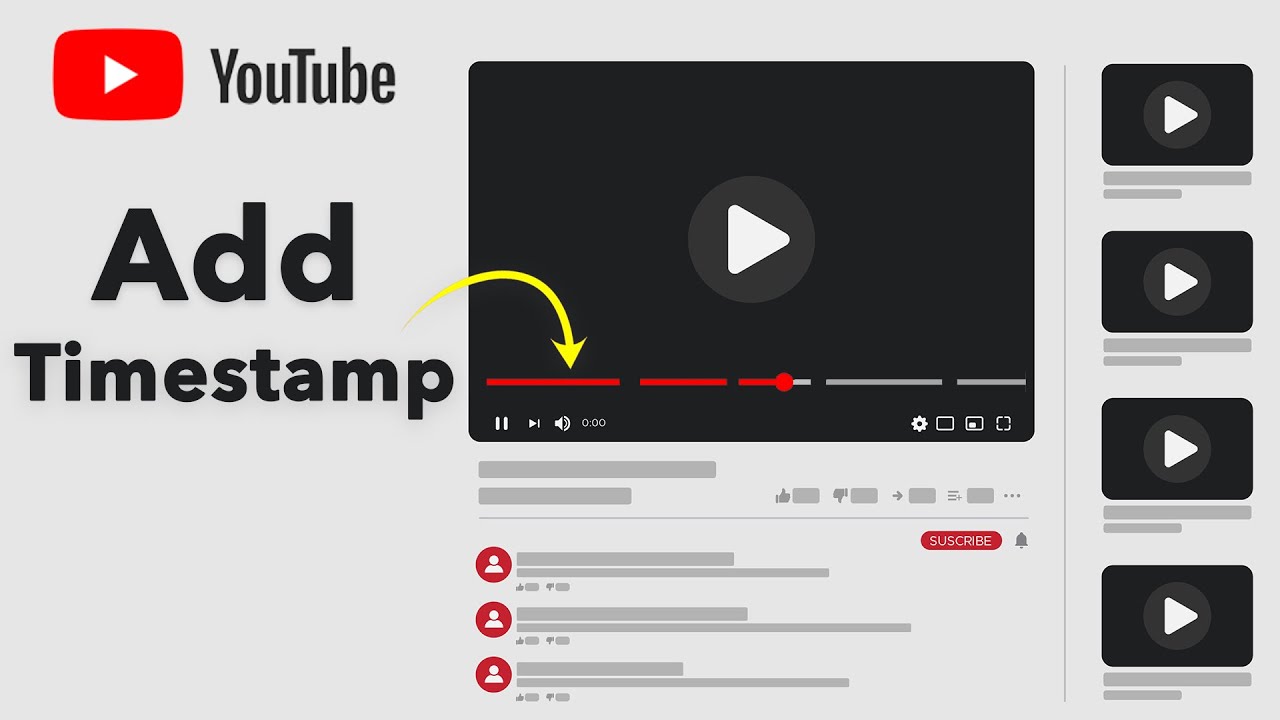
How to Timestamp a YouTube Link: A Comprehensive Guide
In today’s fast-paced digital landscape, sharing videos has become an integral part of communication and information dissemination. YouTube, as the leading video-sharing platform, offers a vast library of content. However, sometimes you need to direct viewers to a specific moment within a video, rather than the beginning. This is where timestamping a YouTube link becomes invaluable. This comprehensive guide will walk you through the process of how to timestamp a YouTube link, providing you with various methods and best practices.
Why Timestamp YouTube Links?
Timestamping a YouTube link serves several crucial purposes:
- Enhanced User Experience: Directing viewers to the exact moment they need to see saves them time and frustration.
- Improved Communication: When discussing specific parts of a video, a timestamped link ensures everyone is on the same page.
- Effective Tutorials: In educational content, timestamping allows viewers to quickly access relevant sections.
- Marketing and Promotion: Highlight key moments in a product demo or promotional video.
Methods for Timestamping YouTube Links
There are several straightforward methods for how to timestamp a YouTube link. Let’s explore the most common approaches:
Using the YouTube Share Button
This is perhaps the easiest and most common method. Here’s how it works:
- Open the YouTube Video: Navigate to the YouTube video you want to share.
- Find the Relevant Moment: Pause the video at the exact time you want to timestamp.
- Click the Share Button: Below the video, you’ll find a “Share” button. Click it.
- Check the “Start at” Box: A pop-up window will appear. Look for a checkbox labeled “Start at.” It should automatically populate with the current time.
- Copy the Link: Copy the generated link. This link will now include the timestamp.
This method is quick and requires no manual adjustments, making it ideal for most users.
Manually Adding the Timestamp to the URL
For those who prefer a more hands-on approach, you can manually add the timestamp to the YouTube URL. This method is useful if you need to adjust the timestamp after copying the initial link.
- Copy the YouTube Video URL: Copy the standard YouTube URL from the address bar.
- Determine the Timestamp: Identify the exact minute and second you want the video to start at.
- Add the Timestamp Parameter: Append
&t=XmYsto the end of the URL, where X is the number of minutes and Y is the number of seconds. For example, if you want the video to start at 1 minute and 30 seconds, you would add&t=1m30s. Alternatively, you can specify the total number of seconds, such as&t=90sfor 1 minute and 30 seconds.
Example:
Original URL: https://www.youtube.com/watch?v=dQw4w9WgXcQ
Timestamped URL (starting at 1 minute 30 seconds): https://www.youtube.com/watch?v=dQw4w9WgXcQ&t=1m30s or https://www.youtube.com/watch?v=dQw4w9WgXcQ&t=90s
This method provides more control over the timestamp and is useful for fine-tuning the starting point.
Using the YouTube Studio Editor
If you’re a content creator, the YouTube Studio Editor offers another way to how to timestamp a YouTube link. This method is particularly useful for creating chapter markers within your video.
- Go to YouTube Studio: Sign in to your YouTube account and go to YouTube Studio.
- Select the Video: Find the video you want to edit and click on it.
- Open the Editor: In the left sidebar, click on “Editor.”
- Add Chapter Markers: In the video description, add timestamps in the format
0:00 Introduction,1:30 Main Topic, etc. - Save Changes: Save the changes to the video.
While this method doesn’t directly create a timestamped link, it allows viewers to easily navigate to specific sections of your video using chapter markers, which effectively serves the same purpose. These chapters are visible in the video progress bar and in the video description.
Best Practices for Timestamping YouTube Links
To ensure your timestamped links are effective and user-friendly, consider these best practices:
- Accuracy: Double-check the timestamp to ensure it points to the exact moment you intend.
- Clarity: When sharing the link, briefly explain why you’re directing viewers to that specific moment.
- Context: Provide context around the timestamped section to help viewers understand its relevance.
- Mobile Compatibility: Test the timestamped link on both desktop and mobile devices to ensure it works correctly.
- Conciseness: If you’re manually adding the timestamp, use the shortest possible format (e.g.,
&t=90sinstead of&t=1m30s) to keep the URL clean.
Troubleshooting Common Issues
While timestamping YouTube links is generally straightforward, you might encounter a few issues. Here are some common problems and their solutions:
- Timestamp Not Working: Ensure the timestamp is correctly formatted (e.g.,
&t=XmYsor&t=Xs). Double-check that you haven’t made any typos. - Video Starts at the Beginning: If the video still starts at the beginning, the issue might be with the browser or device. Try clearing the browser cache or testing the link on a different device.
- Link Not Recognized: If the link isn’t recognized as a YouTube link, make sure you’ve copied the entire URL correctly.
Advanced Tips and Tricks
Beyond the basic methods, here are some advanced tips and tricks for working with timestamped YouTube links:
- Using Third-Party Tools: Several online tools can help you create timestamped links and even generate embed codes with timestamps.
- Creating Playlists with Timestamps: You can create a YouTube playlist and add videos with specific start times. This is useful for curating content around a particular theme or topic.
- Embedding Videos with Timestamps: When embedding a YouTube video on your website, you can include the
startparameter in the embed code to specify the starting time.
The Future of Timestamping
As YouTube continues to evolve, the importance of timestamping will likely increase. With the rise of long-form content and the growing demand for efficient information consumption, timestamping provides a valuable tool for navigating and sharing videos. Expect to see further enhancements and integrations in the future, making it even easier to how to timestamp a YouTube link and share specific moments with others.
In conclusion, mastering the art of how to timestamp a YouTube link is a valuable skill for anyone who frequently shares or consumes video content. Whether you’re a student, educator, marketer, or simply a casual viewer, timestamping can significantly enhance your YouTube experience. By following the methods and best practices outlined in this guide, you can ensure that your links are accurate, effective, and user-friendly. [See also: YouTube SEO Tips] and [See also: How to Create Engaging YouTube Content].
Remember to always double-check your timestamps and provide context to your viewers, ensuring they get the most out of the shared content. Understanding how to timestamp a YouTube link empowers you to share information effectively and enhance the viewing experience for others.

